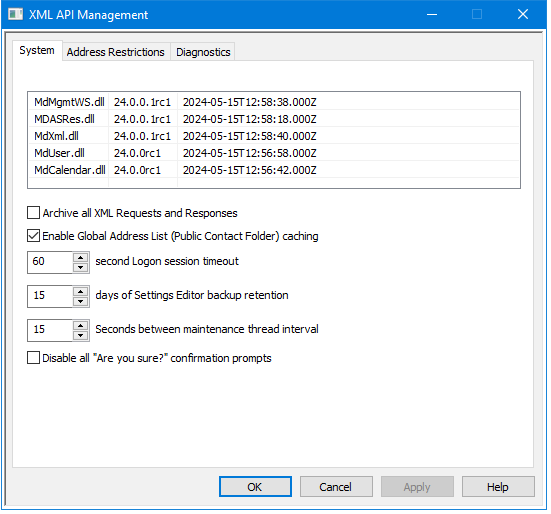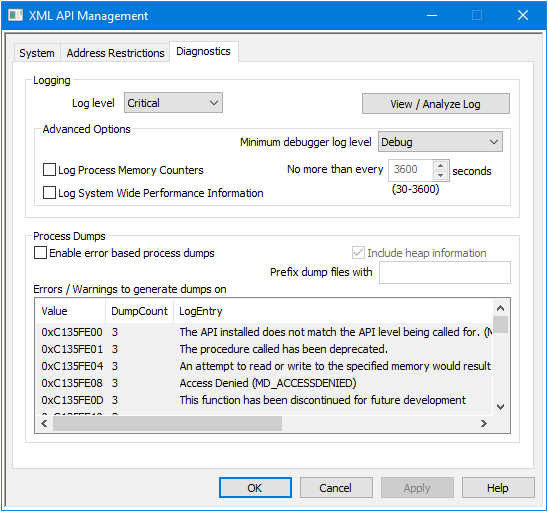This dialog contains various management settings for MDaemon's XML API service. For more on MDaemon's API library and integrating your custom applications with MDaemon, see: MD-API.html (located in the \..\MDaemon\Docs\API folder).
System

Archive all XML Requests and Responses
Enable this option is you wish to save all XML requests and responses so that you can diagnose issues that may arise.
Enable Global Address List (Public Contact Folder) caching
Use this option if you wish to allow the API to keep the Global Address Lists (public contacts folders) for domains cached, in order to improve performance. This option is enabled by default.
[xx] second Logon session timeout
This option determines the number of seconds before an API Logon token expires if not used.
[xx] days of Settings Editor backup retention
This option determines the number of days to retain Editor/INIfile and Editor/HiWater backups, so that changes might be undone/reverted via the 'recover' action.
[xx] Seconds between maintenance thread interval
This is the number of seconds that the maintenance thread sleeps before checking for new maintenance tasks such as cleaning up old directories and files.
Disable all "Are you sure?" confirmation prompts
Check this box if you wish to disable all 'Are you sure?' prompts to streamline UI actions.
Address Restrictions

Allowed Addresses
Right-click to add a new IP address/mask to the allowed addresses list. These addresses are allowed to connect to the API.
Allow all Trusted IP addresses
Check this box if you wish to allow all Trusted IP addresses to connect to the API.
Allow all LAN IP Addresses
Check this box if you wish to allow all LAN IP addresses to connect to the API.
Allow all Dynamic Allow List addresses
Use this option if you wish to allow all Dynamically Allowed addresses to connect to the API.
Blocked Addresses
Right-click to add or modify IP addresses in this list. These IP addresses are restricted from connecting to the API.
Deny all IP addresses not specifically allowed
When this box is checked, the only IP addresses allowed to connect to the API are those specifically allowed to connect via the Allowed Addresses settings.
Diagnostics

Logging
Log level
Six levels of logging are supported, from the highest to lowest amount of data logged:
Debug |
This is the most extensive log level. Logs all available entries, and is typically only used when diagnosing a problem, or when the administrator wants detailed information. |
Info |
Moderate logging. Logs general operations without details. This is the default log level. |
Warning |
Warnings, errors, critical errors, and startup/shutdown events are logged. |
Error |
Errors, critical errors, and startup/shutdown events are logged. |
Critical |
Critical errors and startup/shutdown event are logged. |
None |
Only startup and shutdown events are logged. |
View/Analyze Log
Click this button to open the MDaemon Advanced System Log Viewer. By default the logs are stored in: "..\MDaemon\Logs\"
Advanced Options
Minimum debugger log level
This is the minimum level of logging to emit to the debugger. The available log levels are the same as those outlined above.
Log process memory counters
Check this box to log process-specific Memory, Handle, and Thread information to the log file. This is useful for finding potential leads and resource allocation issues. Log entries will only be emitted if the data has changed since the last time it was logged.
Log system wide performance information
Check this box if you with to log system-wide performance information to the log file. This is useful for finding potential leads and resource allocation issues. Log entries will only be emitted if the data has changed since the last time it was logged.
No more than every [xx] seconds
Use this option to set the limit on how often the process and performance information will be logged.
Process Dumps
Enable error based process dumps
Enable this option if you want to generate process dumps whenever a specific warning or error occurs that you have designated below.
Include heap information in dumps
By default, heap information is included in the process dumps. Clear this checkbox if you do not wish to include it.
Prefix dump files with
Process dump filenames will begin with this text.
Errors/Warnings to generate dumps on
Right-click this area and use the Add/Edit/Delete Entry... options to manage the list of errors or warnings that will trigger process dumps. For each entry you can specify the number of process dumps allowed before it will be deactivated.